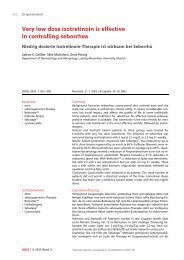Clinical Study Report - Calidad de Información CFR
Clinical Study Report - Calidad de Información CFR
Clinical Study Report - Calidad de Información CFR
You also want an ePaper? Increase the reach of your titles
YUMPU automatically turns print PDFs into web optimized ePapers that Google loves.
events whose causal reations to the study drug cannot be exclu<strong>de</strong>d are <strong>de</strong>fined as adverse drug<br />
reactions (ADRs).<br />
2) Observation period<br />
The observation period in this study starts when the subject signs the informed consent form<br />
is signed, and ends 14 days after the last protocol visit is ma<strong>de</strong>.<br />
3) Method<br />
i) The principal investigator and the sub-investigator have a responsibility for recording all<br />
AEs observed during the clnical trial. AEs should be recor<strong>de</strong>d in medical terms if possible. If<br />
it is not possible, then signs or symptoms should be <strong>de</strong>scribed based on observations by<br />
the principal investigator/sub-investigator or reported by the subject.<br />
ii) Regardless of causal relationship to the study drug, all AEs should be thoroughly monitored<br />
until they are resolved. Thair outcomes have to be evaluated.<br />
iii) Symptoms, signs, onset and termination dates, severity, actions taken, and serious AEs<br />
should be recor<strong>de</strong>d in CRF. AEs’ causal relationships to the study drug have to be assessed.<br />
4) Severity of AE<br />
i) Mild: An AE is consi<strong>de</strong>red mild if it does not infere with everyday activities. The subject may<br />
not recognize a mild AE. Most mild AEs do not require treatment.<br />
ii) Mo<strong>de</strong>rate: An AE is consi<strong>de</strong>red mo<strong>de</strong>rate if it interferes with normal daily activities. A<br />
mo<strong>de</strong>rate AE may make the subject uncomfortable. The subject may keep participating in<br />
the trial, but may need treatment.<br />
iii) Severe: An AE is consi<strong>de</strong>red severe if it prevents the subjects from normal daily activities.<br />
A severe AE makes the subject very uncomfortable. The subject may stop the treatment,.<br />
The subject may be treated for the AE or may even have to be hospitalized.<br />
5) Causal Relationship to <strong>Study</strong> Drug<br />
i) Definite: Onset of AE is associated with administrating time of the study drug. The study<br />
drug explains onset of AE most directly than other factors.<br />
ii) Probable: Therer is association between onset of AE and administrating time of the study<br />
drug. The study drug explains onset of AE more than other factors.<br />
iii) Possible: Therer is association between onset of AE and administrating time of the study<br />
drug, however other possible factors explain onset of AE as much as the study drug does.<br />
iv) Improbable: Therer is no reasonable relationship between onset of AE and administrating<br />
time or type of the study drug, or there exists other probable cause.<br />
CSR_Clotinab_II 34<br />
Ver. 1.0_Eng



